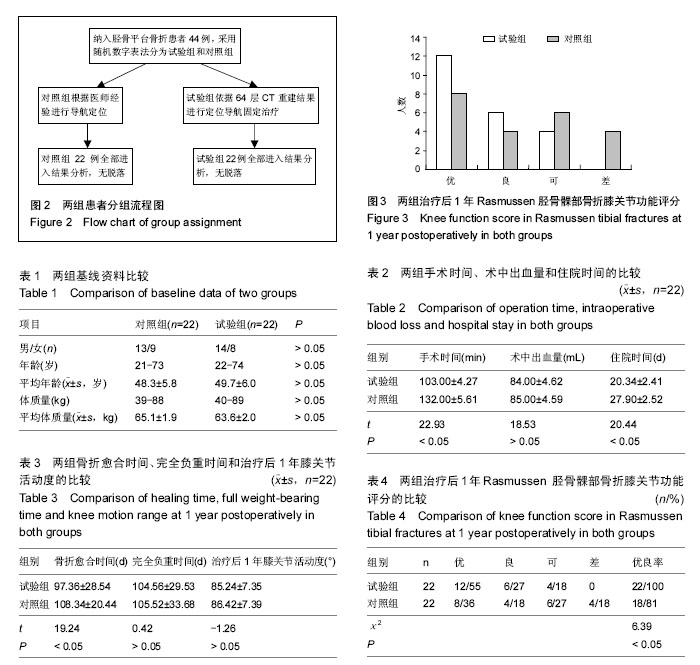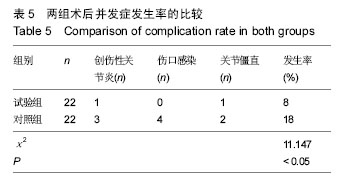| [1] 王发成,曹海念,许忠曦.64排螺旋CT三维重建与X线平片在胫骨平台骨折诊断中的对比[J].中国中医药现代远程教育, 2010,8(2):139-141.
[2] Baumann P,Ebneter L,Giesinger K,et al.A triangular support screw improves stability for lateral locking plates in proximaltibial fractures with metaphyseal comminution: a biomechanical analysis.Arch Orthop Trauma Surg.2011;131(6):815-821.
[3] 戴志龙,芦中庆,侯建明,等.多层螺旋CT后处理技术对胫骨平台隐匿性骨折的诊断价值[J].临床军医杂志, 2010, 38(5):807-909.
[4] 杜国生,华亮,薛源,等.术前CT扫描三维重建对胫骨平台骨折手术方式和内固定选择的评价[J].中国医药指南, 2011,9(21):34-36.
[5] 洪敏昌,张文英,周应平.多层螺旋CT二维三维重建技术在骨关节骨折中的应用[J].实用医学影像杂志,2011,12(2): 102-103.
[6] Vendeuvre T,Babusiaux D,Breque C,et al.Tuberoplasty: Minimally invasive osteosynthesis technique for tibial plateau fractures.Orthop Traumatol Surg Res.2013; 99(4 Suppl):S267-272.
[7] 丁燕萍,杨莹.64 排螺旋CT三维重建在胫骨平台骨折修复中的价值[J].中国组织工程研究,2015,19(4):612-617.
[8] 丁勇明,陶振东,巢玉柳.CT三维重建技术在胫骨平台骨折中的临床应用[J].临床医学工程,2013,20(9):1069-1070.
[9] 王小进,白卓杰,张本善,等.16层螺旋CT三维重建在诊断胫骨平台骨折中的价值[J].中外医疗,2012,31(33): 168-169.
[10] 林义才,赵劲民,花奇凯,等.三柱分型指导治疗胫骨平台骨折疗效分析[J].广西医科大学学报,2012,29(2):272-274.
[11] Siegler J,Galissier B,Marcheix PS,et al.Percutaneous fixation of tibial plateau fractures under arthroscopy: a medium term perspective.Orthop Traumatol Surg Res. 2011;97(1):44-50.
[12] 方挺松,柯祺,黄钰坚,等.胫骨平台骨折患者膝关节韧带及半月板损伤的多层螺旋CT诊断[J].现代医用影像学,2014, 19(2):96-99.
[13] 钟开祥,赵云娥.16 层螺旋CT后处理技术对外伤性胫骨平台骨折的诊断价值[J].实用医学影像杂志, 2012,13(2): 110-112.
[14] 王振强,闫呈新,张玉敏.128层螺旋CT的MRP和VR在胫骨平台骨折中的应用[J].医学影像学杂志,2011,21(9): 1401-1403.
[15] Zhu Y,Yang G,Luo CF,et al.Computed tomography-based Three -Column Classification in tibial plateau fractures:introduction of its utility and assessment of its reproducibility.J Trauma Acute Care Surg.2012;73 (3):731-737.
[16] 中华创伤骨科杂志编辑委员会.胫骨平台骨折诊断与治疗的专家共识[J].中华创伤骨科杂志,2015,17(1):3-7.
[17] Yang G,Zhai Q,Zhu Y,et al.The incidence of posterior tibial plateau fracture:an investigation of 525 fractures by using a CT-based classification system.Arch Orthop Trauma Surg.2013;133(4):929-934.
[18] Chang SM,Zhang YQ,Yao MW,et al.Schatzker type Ⅳ medial tibial plateau fractures: a computed tomography -based morphological subclassification. Orthopedics. 2014;37(8):699-706.
[19] te Stroet MA,Holla M,Biert J.The value of a CT scan compared to plain radiographs for the classification and treatment plan in tibial plateau fractures.Emerga Radiol.2011;18(3):279-283.
[20] 张国强,丁尔勤.胫骨平台骨折的诊疗进展[J].中国骨与关节损伤杂志,2014,29(10):1078-1079.
[21] 左树青,丰佳萌.64排螺旋CT后处理技术在胫骨平台骨折中的应用价值[J].中国当代医药,2013,20(12):116-117.
[22] 尹虎.三维CT重建在复杂性胫骨平台骨折治疗中应用的价值[J].现代中西医结合杂志,2014,25(9):2791-2792.
[23] Wang J,Wei J,Wang M.The distinct prediction standards for radiological assessments associated with soft tissue injuries in the acute tibial plateau fracture.Eur J Orthop Surg Traumatol.2015;25(5): 913-920.
[24] 易壁星,张博,蔡武,等.64层CT重建技术在胫骨平台骨折诊疗中的应用价值[J].中国CT和MRI杂志,2011,9(2): 58-60.
[25] de Lima Lopes C,da Rocha Candido Filho CA,de Lima E Silva TA,et al.Importance of radiological studies by means of computed tomography for managing fractures of the tibial plateau.Rev Bras Ortop.2014; 49(6):593-601.
[26] 王志军,龚瑞,赵凯,等.16排螺旋CT对胫骨平台骨折分型的诊断价值[J].陕西医学杂志,2011,40(3):290-292.
[27] Hu YL,Ye FG,Ji AY,et al.Three-dimensional computed tomography imaging increases the reliability of classification systems for tibial plateau fractures. Injury.2009;40(2):1282-1285.
[28] Dodd A,Oddone Paolucci E,Korley R.The effect of three-dimensional computed tomography reconstructions on preoperative planning of tibial plateau fractures:a case control series.BMC Musculoskelet Disord.2015;16(6):144-149.
[29] 谢卫宁,杨英年,李华,等.AO/OTA及三柱分型联合应用指导治疗累及后柱的胫骨平台骨折[J].中国骨与关节损伤杂志,2014,29(10):1052-1053.
[30] Patange Subba Rao SP,Lewis J,Haddad Z,et al. Three-column classification and Schatzker classification: a three-and two-dimensional computed tomography characterization and analysis of tibial plateau fractures.Eur J Orthop Surg Traumatol. 2014; 24(7):1263-1270.
[31] Chen XH,Wu XW,Lin HB,et al.Three-dimensional reconstruction reduction and design of digital plates for proximal tibia fracture. Zhongguo Zuzhi Gongcheng Yanjiu.2015;19(26):4235-4241.
[32] 郑晓晖,张国栋,黄华军,等.基于三维编辑的四肢骨折快速虚拟复位[J].中华临床医师杂志(电子版),2015,4(9):617-622.
[33] 张国栋,林海滨,陈宣煌,等.基于多平面三维测量的髋臼骨折数字化内固定植入方案[J].中华临床医师杂志:电子版, 2012,6(80:2010-2015.
[34] 蔡伟斌,胡鸿璇,郭新辉.锁定加压钢板与解剖钢板置入内固定治疗复杂胫骨平台骨折[J].中国组织工程研究, 2012, 16(52):9750-9755.
[35] 刘俊,刘锦波,王生介,等.双钢板治疗胫骨平台粉碎性骨折的临床研究[J].实用临床用药杂志,2014,18(7):129-131.
[36] Kantelhardt SR,Martinez R,Baerwinkel S,et al. Perioperative course and accuracy of screw positioning in conventional,open robotic-guided and percutaneous robotic-guided,pedicle screw placement. Eur Spine J.2011;20(6):860-868.
[37] 田伟,郎昭,刘亚军,等.术中即时三维导航辅助下轴性旋转腰椎椎弓根螺钉置入的实验研究[J].中华外科杂志, 2010, 48(11):838-841.
[38] Chen C,Ruan D,Wu C,et al.CT morphometric analysis to determine the anatomical basis for the use of transpedicular screws during reconstruction and fixations of anterior cervical vertebrae.PLoS One.2013; 8(12):e81159.
[39] 陈宣煌,张国栋,吴长福,等.数字化颈前路螺钉内固定方案设计:Ⅱ型齿状突骨折的临床应用[J].中国组织工程研究, 2013,17(26):4926-4933.
[40] Tabaraee E,Gibson AG,Karahalios DG,et al. Intraoperative cone beam-computed tomography with navigation (O-ARM) versus conventional fluoroscopy (C-ARM): a cadaveric study comparing accuracy,efficiency,and safety for spinal instrumentation. Spine (Phila Pa 1976).2013;38(22):1953-1958. |
.jpg)


.jpg)
.jpg)